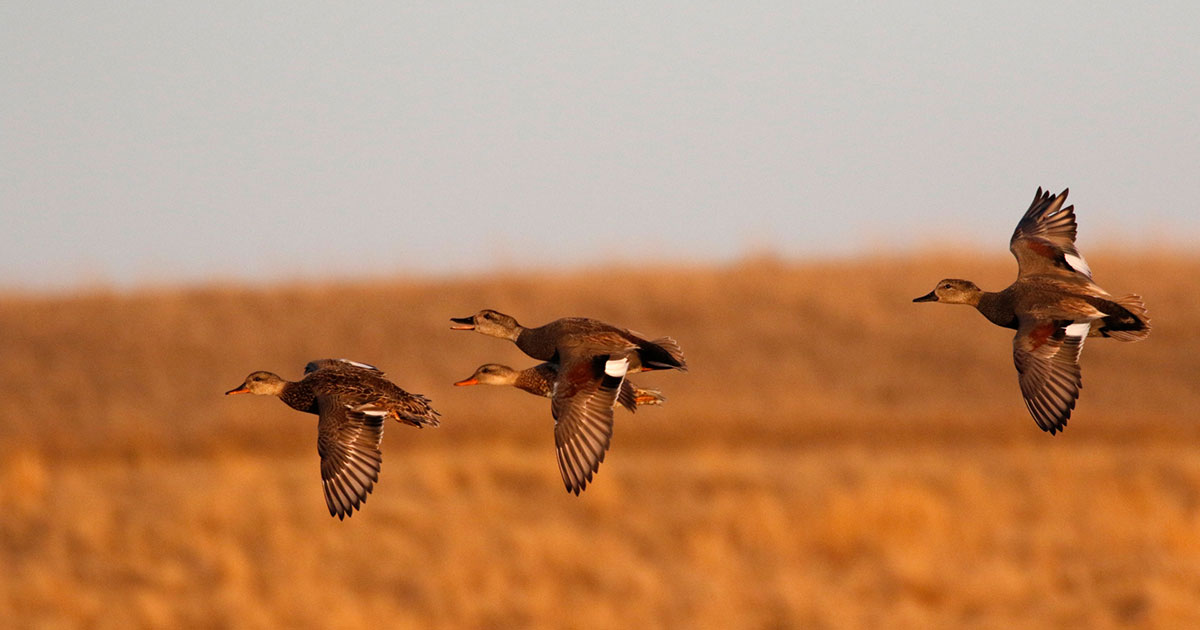Migration Alert: Louisiana Habitat Improving, Duck Numbers Up from November
Dec. 15, 2023 – Mississippi Flyway – Louisiana
Dec. 15, 2023 – Mississippi Flyway – Louisiana

Louisiana's first split was a tale of two extremes. Despite record-low duck numbers from the November aerial survey, some hunters had a great start, and others did not fare as well. However, the biggest issue is that the extended drought conditions have eased somewhat in many areas across the state due to much-needed rainfall.
The second split opened in the West zone on Monday, December 11, and the East reopens on the 16th. Captain Kirk Stansel with Hackberry Rod and Gun near Lake Charles says their operation is having a banner season so far. "It has probably been the best season we have had in 8-10 years. My guess is we have water and groceries. Gadwall is our primary duck, but also wigeon, green- and blue-winged teal, scaup, and a few pintails," Stansel said.
Stansel's observation about food and water has been the theme across the state due to the drought. On the other end of the spectrum, Darren Digby hunts in the Delacroix marsh area of Southeast Louisiana and has water but no feed. "The first split overall was tough, way down on grays from usual, though saw an uptick in green wings. One of the lowest production first splits on my log that's now 20 years old. A buddy hunted our marsh lease Monday, though, and didn't even shoot – worst hunt of the season," Digby said. "In Delacroix, there is no food at all; the salinity from summer drought zapped it. We usually have food even during a storm year, but this year none, and the birds know it," he added. Looking for better opportunities, Digby will turn his attention to another lease with AG land in Avoyelles Parish. "We just got water this week; it was a pretty good first split for the water we had. Expecting it to be much better now," he said.
The numbers are in for the December survey and while not great, they are much improved from last month. "The December 2023 estimate of ducks in Louisiana's coastal zone and Little River Basin is 853,000. This represents a 46% increase from last month's record low estimate of 584,000," said Jason Olszak, Waterfowl Program Leader for Louisiana Department of Wildlife and Fisheries." Most of the state received much-needed rain in the past month, elevating drought conditions from exceptional to extreme in some regions. With the large improvement in wetland habitat abundance, it is not surprising that duck figures increased from the record-low estimate during the exceptional drought conditions experienced across the entire state during the November survey," Olszak said.
Colby Daniels, owner/guide at Top Gun Guides in Mer Rouge, is looking forward to the East zone reopening as they are coming off of an above-average first split. "We were a little concerned because the dry conditions allowed the farmers to harvest and work nearly every acre, but it doesn't seem to have affected the ducks and geese. We killed a good mix of ducks in the first split: pintails, gadwalls, wigeon, teal, shovelers, and a handful of mallards. The specks were awesome in early speck season and throughout the first split," Daniels said. "Going by the numbers we are seeing as we are brushing blinds, the second split is going to start just like it left off – strong," he added.
The Southwest area of the state continues to be a bright spot and consistently accounts for higher numbers of birds in the survey. For December, the Southwest had 458,000 total ducks, whereas the Southeast totaled 380,000. While both numbers are up from last month, they still remain significantly below the long-term average. However, hunters in the Southwest continue to report decent bags.
Doug Dowden, owner/operator of 17Seven Outfitters LLC has the benefit of access to diverse habitat, which really helped during the drought conditions for the first split. "We try to utilize all the different options SWLA has to offer for waterfowling. We hunt freshwater impoundments, freshwater/brackish marsh, flooded rice fields, flooded millet fields, and flooded pasture. Having that access afforded us the best opportunities given the conditions. Our blinds stayed very consistent with bags of blue-wing and green-wing teal, gadwall, pintails, a few divers, and a surprising increase in mallards so far this season," he said.
Dowden is optimistic for the remainder of the season. "With the opener being on a Monday, not many shots were heard, mainly due to not many being able to hunt, is my belief. So far this second split, the ducks seem a little scattered with a lot of fresh food being flooded. So that was expected. The geese have finally shown up in full force. Overall, we still need some rain to make things ideal for ducks in our area," Dowden said.
Captain John Saucier with Sportsman Charters LLC hunts in the Gueydan area. Like most others, water was a key factor. "It was a somewhat slow first season for most because of lack of water in our area. Luckily, we had some water because of deep water wells on some of our farms. We killed over 500 ducks though, which is good for us that part of the year. Our hunting has been trending to later in the year, with December and January being our best time of the season. I think our season opens way to early in November. The second split is off to a good start for us and a good bit of geese have also moved into this area," Saucier said.
Stay up to date with the latest migration information.